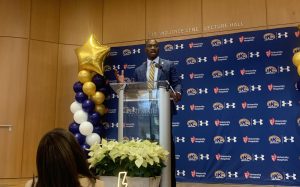University administration learns to embrace May 4
May 3, 2010
Students blamed governor for tragedy
They weren’t mad at the administration, said Patrick Mullen, chairman of the university’s Board of Trustees and a Kent State alumnus.
They were mad at the governor.
Mullen, then a 20-year-old accounting major, was sitting in a finance class on May 4, 1970, petitioning his professor to postpone an exam — with tensions swelling between National Guard troops and protestors, the campus was becoming too chaotic, he argued.
“He slammed his hands down on the his desk and said it wouldn’t be postponed and, by the way, you guys should be here to study not to protest,” Mullen said. “Little did he know that as he was saying this students were being shot.”
Mullen said he left the classroom and went to Blanket Hill, where ambulances were arriving and several professors had students sit down on the grass. Moments later, he would have a gun aimed at him by an Ohio National Guardsman ordering him to leave the scene.
The narrative surrounding the May 4 shootings is well known. On May 2, 1970, Ohio Gov. James A. Rhodes ordered the National Guard into Kent to quell growing student protests. Four students would die on campus two days later. Another nine were injured.
Then-Kent State President Robert White and his administration, meanwhile, remained relatively silent.
“There was a disappointment on the part of the students that the president of the university did not take a more active role,” said Carole Barbato, Kent State professor and student at the time of the shootings. “But there was a belief that the president was generally not to blame, theoretically. There was just definitely a climate of mistrust.”
Mullen said the university’s lack of response in 1970 would be an impossibility today.
“My impression is that (the administration) wanted to as quickly as possible put this behind them,” he said. “Now the administration, the faculty and the board not only embrace it but support it. So that wouldn’t happen today. Our administration would be front and center on this.”
Though the university held official observances in the years following the shootings, much of the early commemoration efforts were led by the original May 4 Task Force and several of the shooting victims.
“The way the administration worked in 1970 was like (the shootings) were everybody else’s problem,” Mullen said.
It wasn’t until former President Carol Cartwright’s administration that the relationship between Kent State and the families of the slain students improved.
“I think there has been quite a change (in the way the university handles May 4),” Barbato said. “It’s not like the university totally ignored May 4. They just didn’t embrace it as they do now.”
Cartwright would be the first president of the university to take part in the annual candlelight vigil.
In the aftermath of the shootings, the university created the Center for Peaceful Change, now called the Center for Applied Conflict Management, and raised money for scholarships in the names of the four students who died that day.
And as the effort was underway to have the May 4 shootings site added to the National Register of Historic Places, board members including Mullen, petitioned in its favor — a signal that university officials wanted official acknowledgement of Kent State’s tragic place in history.
“A lot has changed,” President Lester Lefton said. “Town-gown relations are the best they’ve ever been. What we’ve been trying to explain is what happened at Kent State wasn’t about Kent State. It was a time of dramatic political and social change. The protests happened, but May 4 doesn’t define Kent State.”
Contact administration reporter Jenna Staul at [email protected].












